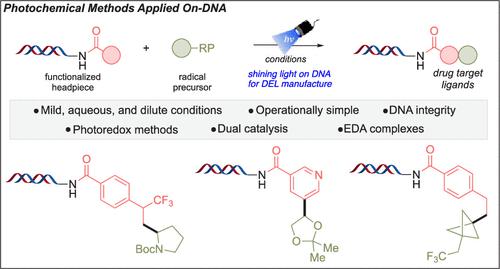当前位置:
X-MOL 学术
›
Acc. Chem. Res.
›
论文详情
Our official English website, www.x-mol.net, welcomes your
feedback! (Note: you will need to create a separate account there.)
Photochemical Methods Applied to DNA Encoded Library (DEL) Synthesis
Accounts of Chemical Research ( IF 16.4 ) Pub Date : 2023-01-19 , DOI: 10.1021/acs.accounts.2c00778 Bianca Matsuo 1 , Albert Granados 1 , Guillaume Levitre 1 , Gary A Molander 1
Accounts of Chemical Research ( IF 16.4 ) Pub Date : 2023-01-19 , DOI: 10.1021/acs.accounts.2c00778 Bianca Matsuo 1 , Albert Granados 1 , Guillaume Levitre 1 , Gary A Molander 1
Affiliation

|
DNA-encoded library technology (DELT) is a new screening modality that allows efficient, cost-effective, and rapid identification of small molecules with potential biological activity. This emerging technique represents an enormous advancement that, in combination with other technologies such as high-throughput screening (HTS), fragment-based lead generation, and structure-based drug design, has the potential to transform how drug discovery is carried out. DELT is a hybrid technique in which chemically synthesized compounds are linked to unique genetic tags (or “barcodes”) that contain readable information. In this way, millions to billions of building blocks (BBs) attached on-DNA via split-and-pool synthesis can be evaluated against a biological target in a single experiment. Polymerase chain reaction (PCR) amplification and next-generation sequencing (NGS) analysis of the unique sequence of oligonucleotides in the DNA tag are used to identify those ligands with high affinity for the target. This innovative fusion of genetic and chemical technologies was conceived in 1992 by Brenner and Lerner (Proc. Natl. Acad. Sci. 1992, 89, 5381–5383) and is under accelerated development with the implementation of new synthetic techniques and protocols that are compatible with DNA. In fact, reaction compatibility is a key parameter to increasing the chances of identification of a drug target ligand, and a central focus has been the development of new transformations and the transition to robust protocols for on-DNA synthesis. Because the sole use of the DNA tag is as an amplifiable identification barcode, its structural integrity during a new chemical process is mandatory. As such, the use of these sensitive, polyfunctional biological molecules as substrates typically requires aqueous solutions within defined pH and temperature ranges, which is considered a notable challenge in DEL synthesis.
中文翻译:

光化学方法应用于 DNA 编码文库 (DEL) 合成
DNA 编码文库技术 (DELT) 是一种新的筛选方式,可以高效、经济且快速地鉴定具有潜在生物活性的小分子。这种新兴技术代表了巨大的进步,与高通量筛选 (HTS)、基于片段的先导化合物生成和基于结构的药物设计等其他技术相结合,有可能改变药物发现的方式。 DELT 是一种混合技术,其中化学合成的化合物与包含可读信息的独特遗传标签(或“条形码”)相连。通过这种方式,可以在单次实验中根据生物靶标评估通过分流合成连接到 DNA 上的数百万至数十亿个构建块 (BB)。对 DNA 标签中寡核苷酸的独特序列进行聚合酶链式反应 (PCR) 扩增和新一代测序 (NGS) 分析,用于识别与靶标具有高亲和力的配体。这种遗传和化学技术的创新融合是由 Brenner 和 Lerner 于 1992 年提出的( Proc. Natl. Acad. Sci . 1992 , 89, 5381–5383),并且随着兼容的新合成技术和协议的实施,正在加速开发。与DNA。事实上,反应相容性是增加药物靶标配体识别机会的关键参数,核心焦点是新转化的开发以及向 DNA 合成的稳健方案的过渡。由于 DNA 标签的唯一用途是作为可放大的识别条形码,因此在新的化学过程中其结构完整性是强制性的。 因此,使用这些敏感的多功能生物分子作为底物通常需要在规定的 pH 值和温度范围内的水溶液,这被认为是 DEL 合成中的一个显着挑战。
更新日期:2023-01-19
中文翻译:

光化学方法应用于 DNA 编码文库 (DEL) 合成
DNA 编码文库技术 (DELT) 是一种新的筛选方式,可以高效、经济且快速地鉴定具有潜在生物活性的小分子。这种新兴技术代表了巨大的进步,与高通量筛选 (HTS)、基于片段的先导化合物生成和基于结构的药物设计等其他技术相结合,有可能改变药物发现的方式。 DELT 是一种混合技术,其中化学合成的化合物与包含可读信息的独特遗传标签(或“条形码”)相连。通过这种方式,可以在单次实验中根据生物靶标评估通过分流合成连接到 DNA 上的数百万至数十亿个构建块 (BB)。对 DNA 标签中寡核苷酸的独特序列进行聚合酶链式反应 (PCR) 扩增和新一代测序 (NGS) 分析,用于识别与靶标具有高亲和力的配体。这种遗传和化学技术的创新融合是由 Brenner 和 Lerner 于 1992 年提出的( Proc. Natl. Acad. Sci . 1992 , 89, 5381–5383),并且随着兼容的新合成技术和协议的实施,正在加速开发。与DNA。事实上,反应相容性是增加药物靶标配体识别机会的关键参数,核心焦点是新转化的开发以及向 DNA 合成的稳健方案的过渡。由于 DNA 标签的唯一用途是作为可放大的识别条形码,因此在新的化学过程中其结构完整性是强制性的。 因此,使用这些敏感的多功能生物分子作为底物通常需要在规定的 pH 值和温度范围内的水溶液,这被认为是 DEL 合成中的一个显着挑战。











































 京公网安备 11010802027423号
京公网安备 11010802027423号